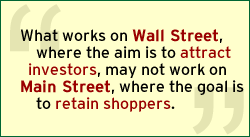In an $11 billion deal announced late last year, Sears and Kmart are coming together to create the third largest U.S. retailer. Their presence will be formidable, with upwards of 3,500 store locations and about $55 billion in annual revenues. Edward Lampert, who reportedly will head the combined company, said this merger would yield "a higher return than either company could achieve on its own." Some experts have already labeled it a "smart" move, allowing the company to compete more aggressively, efficiently, and effectively.
Sears, Roebuck and Co. shares immediately jumped 17%, and Kmart Holding Corporation shares rose almost 8%. Impressive.
Yet there are also experts who question the wisdom of this merger. Some claim that the "customers" who will actually benefit are the investment fund clients who hold shares in the companies, not the shoppers upon whom their future success ultimately depends. As one retail consultant put it, "The financial metrics of the deal look very good, and the retail metrics look terrible."
 |
Stephen Hoch of The Wharton School maintains that "You have two retailers who are doing badly right now. . . . It's hard to fathom how combining them is suddenly going to produce a new entity that will do better." The stock prices may be up, but business at both Kmart and Sears has been sliding.
Location, location, location?
What goodies does the Sears-Kmart merger hold in store for shoppers? What benefits will the new entity offer that will enable it to compete with formidable competitors like Wal-Mart and Target?
First of all, there will be a lot more stores, so it's likely that at least one of them will be close to wherever shoppers are shopping. And, because of the potential for increased efficiencies with combined operations, there may even be some lower prices in the stores.
Better locations and maybe some better prices -- won't that go a long way toward increasing the attractiveness of a retail operation? Not necessarily. Fixing what's easy to fix isn't the same as fixing what needs to be fixed.
ÆéûÜǨû§Organization studies underscore an important conclusion: Convenient locations are almost never a key factor in building enduring customer relationships. They're merely the price of entry -- something that's required to compete. Location rarely is a brand differentiator.
In research-and-development surveys of customers who shop at leading mass retailers in the United States, ÆéûÜǨû§researchers note that "convenience of store locations" doesn't contribute to building strong and passionate customer relationships; it's far more important to staff that store with knowledgeable and helpful employees. (See "The Constant Customer," "Beyond Customer Loyalty," and "People Who Need People" in See Also.) And shoppers who rated a store's employees as extremely friendly and helpful were about 16 times more likely to evidence real "passion" for the store -- a belief that the store represents an irreplaceable part of their lives.
In ÆéûÜǨû§studies of consumer electronics retailers, the same story has emerged: Store employees make much more of a difference to customer relationships than store location. This same pattern has also been found in other retail categories ÆéûÜǨû§has studied (like hardware) and in other countries (including those in Europe and Latin America). In fact, employees have even proven to be every bit as important as price in building lasting customer connections with store shoppers. Location is important. Price is important. But, when it comes to building lasting customer relationships, a store's employees are, in many cases, even more important.
Competing for customer connections
As mentioned in other ÆéûÜǨû§Management Journal articles, consistently profitable store performance requires a focus on creating and nurturing engaged customers. (See "The Engagement Imperative" and "Stress Resistant Customer Relationships" in See Also.) Over the long term, customer engagement is what pays. Thus, when we evaluate the Sears-Kmart merger, we should look not only at its effect on operational efficiencies that matter to investors but also at its potential impact on the factors that matter to customers.
Lampert managed to move Kmart out of bankruptcy by slashing marketing expenses, laying off employees, closing down inefficient stores, and raising some prices. In recognition of his well-publicized focus on eliminating waste, Kmart's shares have risen. However, it should also be noted that Kmart's same-store sales dropped a reported 14% this year.
It's apparent that what works well on Wall Street, where the aim is to attract investors, may not work so well on Main Street, where the goal is to attract and retain shoppers. To forge strong and passionate bonds with Sears-Kmart shoppers, the new company will need to do more than just provide customers with more locations, reduced overhead, or a more efficient operational structure; it must enhance engagement at each and every customer encounter.
Unless this new retail giant proves that it's capable of creating stronger customer connections, there will be no real value to this merger. And that's true for any proposed merger -- whether it's Oracle and PeopleSoft or the potential consolidation of the Federated and May chains. If the customer doesn't benefit, neither will the investor.